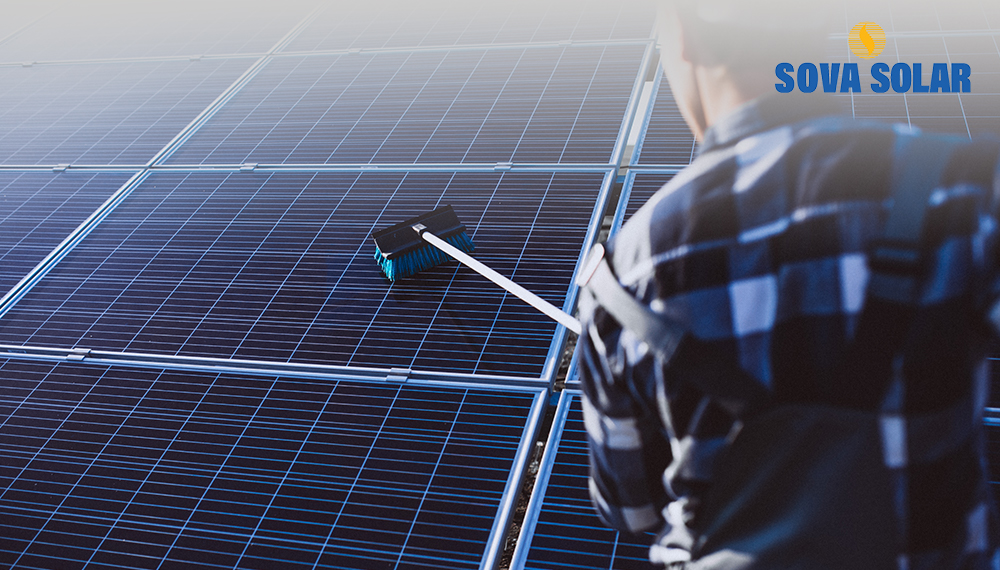
- sovasolar_admin
- Jul 4, 2025
- Uncategorized
- 0 Comments
When sunlight hits a solar panel, we expect it to turn into electricity. But did you know that not all sunlight actually makes it through the surface of the panel? A small portion of it gets reflected away, like light bouncing off a mirror. Over time, these small reflections can add up to a lot of lost energy—unless something is done to stop it.
That’s where ARC coating, or Anti-Reflective Coating, comes into the picture. This invisible layer may seem like a small detail, but in reality, it plays a big role in increasing power output and reducing downtime for industrial solar systems.
Let’s explore what ARC coating is, why it matters, and how it helps industrial solar users get more from every ray of sunlight.
What Is ARC Coating?
ARC stands for Anti-Reflective Coating. It’s a special microscopic layer added to the surface of a solar panel—specifically on the glass that covers the solar cells. Its job is simple but powerful: to reduce the amount of sunlight that reflects off the glass and increase the amount that goes inside the panel.
Without ARC, a portion of light simply bounces off the surface and is lost. With ARC, more light gets absorbed—and more light means more electricity.
Think of it like wearing glasses with an anti-glare finish. You can see better because the reflections are reduced. Solar panels work the same way.
How ARC Coating Works: Simple Science
ARC coatings use the principle of interference. When light hits the coated surface, some of it reflects off the outer layer, and some penetrates deeper. By carefully designing the thickness of the coating (often in nanometers), manufacturers make these light waves cancel each other out.
This way, less light is reflected, and more enters the solar cell, where it gets converted to usable electricity.
It’s a small tweak in design—but it can improve panel efficiency by 2% to 3% or more, depending on conditions.
Why It Matters for Industrial Solar Users
In industrial facilities, where energy demands are high and uptime is critical, every percentage point of extra output matters. Here’s how ARC-coated panels make a difference:
More Energy Yield: With ARC, your solar panels let in more light, meaning they generate more electricity throughout the day. Over weeks, months, and years, this adds up to higher overall yield.
Better Performance in Low Light: ARC coatings help panels capture more light even during early mornings, late evenings, and cloudy days. This extends the productive hours of your solar plant.
Reduced Soiling Loss: Some ARC coatings also resist dust, dirt, and water stains. This means fewer losses from dirt build-up and longer gaps between cleaning cycles.
Lower Downtime: Clean panels produce more power. Panels with anti-reflective, dirt-resistant coatings stay efficient for longer, reducing the need for frequent manual cleaning or shutdowns for maintenance.
Designed for Harsh Indian Conditions
India’s climate is tough on solar panels. From Rajasthan’s dry heat to West Bengal’s heavy rains and Delhi’s dust storms, solar systems face everything. That’s why having the right panel surface makes a big difference.
Sova Solar’s modules are tested to perform in desert-like environments, where intense sun, high temperatures, and airborne particles can challenge panel durability. Their panels include features like:
- High-transmission, low-iron glass with ARC
- Surface durability that resists scratching and wear
- Performance optimization for high UV exposure
These features are not just about looking good—they ensure the panels keep performing day after day, with minimal human intervention.
ARC Coating & ROI: The Hidden Connection
When businesses invest in solar, they’re looking for a strong Return on Investment (ROI). ARC coatings quietly improve that ROI by:
- Improving annual energy generation
- Reducing panel cleaning frequency
- Minimizing maintenance-related downtime
- Enhancing long-term panel stability
In other words, ARC doesn’t just make your panels better—it makes your solar plant smarter and more profitable over time.
Built Into Quality Manufacturing
ARC coating is not something added later—it’s built into the panel at the manufacturing stage. That’s why it’s important to choose panels made by manufacturers who follow international quality processes.
Sova Solar, for example, manufactures its modules in a state-of-the-art, ISO 9001 and ISO 14001 certified facility, and all modules are:
- IEC, CE, and UL certified
- MNRE “A” category rated
- Subjected to performance testing in high-temperature and desert environments
These certifications ensure that the ARC coating—and every other part of the panel—is made to last.
Is ARC Coating a Must-Have?
While panels without ARC coating still work, the performance difference becomes clear over time—especially in industrial settings where:
- Energy costs are high
- Panel accessibility for cleaning is limited
- Downtime must be minimized
In such environments, even a small 2–3% efficiency gain becomes significant when multiplied across hundreds or thousands of panels. It can mean thousands of extra units of electricity—and lakhs saved on utility bills.
Final Thoughts
ARC coating might seem like a tiny part of a solar panel—but its impact is anything but small. By helping solar cells absorb more sunlight and stay cleaner for longer, it plays a key role in maximizing both energy yield and system uptime.
For industries, this means lower costs, better ROI, and a smarter path to energy independence.
And when your panels come from a manufacturer that understands Indian conditions—like Sova Solar—you’re not just buying panels. You’re investing in efficiency, durability, and long-term value.






